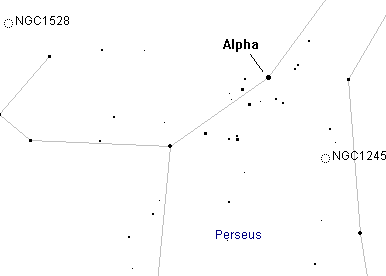The Alpha Persei Association
Jack Kramer
No, it's not the name of some sort of club. The Alpha Persei Association is a group of relatively bright stars that is moving through space together. It gets its name from the fact that the star Alpha Persei is the brightest member. Also designated as Melotte 20 (Mel 20), it's now generally accepted as a true open cluster. But in the past there had been some debate over its status as a cluster, hence the titles "association" and "group" used to describe it. Over 100 stars have been identified as members. From an observational standpoint, the cluster is huge, spanning about three degrees, so it requires an instrument with a very wide field -- binoculars are ideal. I viewed it with a 98mm copyscope in which it appeared large and bright, with one star seeming notably reddish in color. However, the stars are identified as types B to G, which means the coolest is yellow in color. It's possible that the reddish impression is due to contrast with the other white-hot members.

While in the area, you might check out two other nearby open clusters. NGC 1245 is a large, loose cluster containing one star that looks particularly yellow, in contrast to the other blue-white members. NGC 1528 includes many stars of magnitude eight and fainter. Because it's fairly condensed, it stands out well from the background.
The winter months are an especially good time to observe open clusters (also called "galactic" clusters), since there are so many of them in the evening sky during this season. Some are pretty boring; they look just like a group of bright stars. But some have unique aspects, such as multiple stars and certain members of a different color than the others. Then there are open clusters that are so rich and concentrated that they look almost like loose globulars. This can make these objects an interesting pursuit, especially for smaller, wide-field instruments.
Published in the November 1996 issue of the NightTimes




